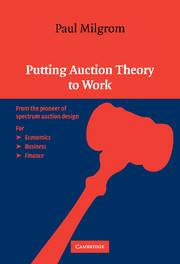PART II - MULTI-UNIT AUCTIONS
Published online by Cambridge University Press: 05 June 2012
Summary
Chapters 3-6 study auctions in which just one kind of item is for sale and each bidder can buy at most a single item. When items are heterogeneous or bidders demand multiple units, new questions arise.
First, even when each bidder wants to buy only one item, if the items are not identical, the mechanism needs to solve the matching problem: who gets which items? One can study the matching problem with a fixed set of bidders to learn how efficiently auctions assign items to bidders and how much revenue they generate. In principle, one could combine these results with analysis of entry to determine who participates in the auction and what kinds of pre-auction investments bidders might make. So far, the auction literature contains little analysis of these questions.
Second, when bidders demand multiple units, market power becomes important. Bidders in auctions, like participants in other kinds of markets, can often reduce the prices they pay by buying fewer units than they would want at the final prices. Reducing demand in this manner can be profitable for a single large bidder even if all the other bidders want to buy only a single unit. When several large bidders each seek to buy multiple units, it is also possible that the larger bidders will coordinate strategies, for example by agreeing to reduce demand in concert.
- Type
- Chapter
- Information
- Putting Auction Theory to Work , pp. 251 - 254Publisher: Cambridge University PressPrint publication year: 2004



